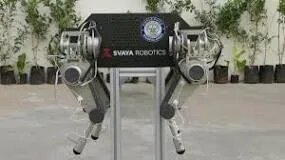Quadruped Robots: A Journey into Automation
In the ever-evolving landscape of robotics, quadruped robots have emerged as remarkable pioneers, captivating the attention of researchers, engineers, and enthusiasts alike. These sophisticated machines, built on the four-legged principle, represent a fascinating venture into automation. This article delves into the world of quadruped robots, exploring their design, applications, and the revolutionary impact they are poised to make.
The Four-Legged Marvels
Quadruped robots, sometimes referred to as “quadbots,” are ingenious mechanical entities that embody a biomimetic approach to robotics. These autonomous marvels are designed with four limbs, typically resembling those of animals, a feature that endows them with unique capabilities. Their design seeks inspiration from the animal kingdom, particularly from creatures such as dogs, cats, and horses. This biomimicry enables them to navigate various terrains with remarkable dexterity and stability, a feat that sets them apart in the world of automation.
The Anatomy of Quadruped Robots
Leg Configuration
The essence of quadruped robots lies in their leg configuration. These robots are meticulously engineered with four legs, which serve as the primary mode of locomotion. The legs are designed with a high degree of articulation, allowing them to mimic the movements of animals. This versatility in leg movement equips quadruped robots with the ability to traverse a multitude of environments, from rugged terrains to urban settings.
Sensing and Perception
A key element in the functionality of quadruped robots is their advanced sensor suite. These robots are equipped with an array of sensors that provide real-time data on their surroundings. This includes LiDAR, cameras, inertial measurement units (IMUs), and proprioceptive sensors on each limb. The combination of these sensors enables the robot to perceive its environment, detect obstacles, and make informed decisions on navigation.
Gait Control
One of the fundamental aspects of quadruped locomotion is gait control. Quadrupeds employ a variety of gaits, depending on the task and terrain. These gaits include the walk, trot, pace, and gallop, each serving a distinct purpose. The robot’s control algorithms are designed to seamlessly transition between these gaits, ensuring stability and adaptability in different scenarios.
Applications of Quadruped Robots
Quadruped robots have transcended the realm of theoretical concepts and have found their way into practical applications across diverse industries. Their versatility and unique locomotion capabilities make them ideal for various tasks.
Exploration and Search
In the field of exploration, quadruped robots have gained prominence. Their ability to traverse rough and unstructured environments makes them valuable assets in search and rescue missions, especially in disaster-stricken areas. These robots can venture into areas inaccessible to traditional wheeled robots, offering hope for swift and efficient responses in times of crisis.
Agriculture and Farming
Agriculture, an industry that continues to embrace automation, is also witnessing the integration of quadruped robots. These robots can navigate agricultural fields with precision, monitor crop health, and even assist in tasks such as planting and harvesting. Their gentle, low-impact footsteps minimize soil compaction, which can be beneficial for sustainable farming practices.
Construction and Inspection
In the construction and infrastructure sector, quadruped robots are being employed for site inspection and maintenance tasks. These robots can access confined or hazardous spaces, conduct inspections, and provide valuable data for maintenance and repair operations. Their ability to scale challenging terrain makes them invaluable in scenarios where human access is restricted.
Military and Defense
The defense industry has also recognized the potential of quadruped robots. These robots can be used for reconnaissance, surveillance, and logistics support. Their capacity to carry payloads and traverse challenging landscapes makes them assets in military applications.
The Future of Quadruped Robots
As technology continues to advance, the future of quadruped robots appears promising. Ongoing research and development efforts are aimed at enhancing their capabilities and expanding their areas of application. Some key areas of development include:
Autonomous Navigation
Advancements in machine learning and AI algorithms are contributing to the development of more sophisticated autonomous navigation systems for quadruped robots. These robots are becoming increasingly adept at making real-time decisions, avoiding obstacles, and adapting to changing environments.
Human-Robot Interaction
Another significant avenue of research is improving human-robot interaction. Researchers are working on developing natural and intuitive interfaces for controlling and communicating with quadruped robots. This can include voice commands, gestures, and augmented reality interfaces.
Payload Capacity
Researchers are also focusing on increasing the payload capacity of quadruped robots, making them more versatile for various applications. Enhanced payload capacity would open up possibilities for logistics, transport, and heavy-duty tasks.
Conclusion
Quadruped robots represent a journey into automation that combines the wonders of biomimicry with cutting-edge technology. Their unique legged locomotion, sensing capabilities, and adaptability have made them indispensable in a range of applications, from exploration to agriculture and defense. As research and development in this field continue to progress, the future holds even more exciting possibilities for these mechanical marvels. The evolution of quadruped robots promises to shape the landscape of automation, offering innovative solutions to challenges across various domains.






Comments